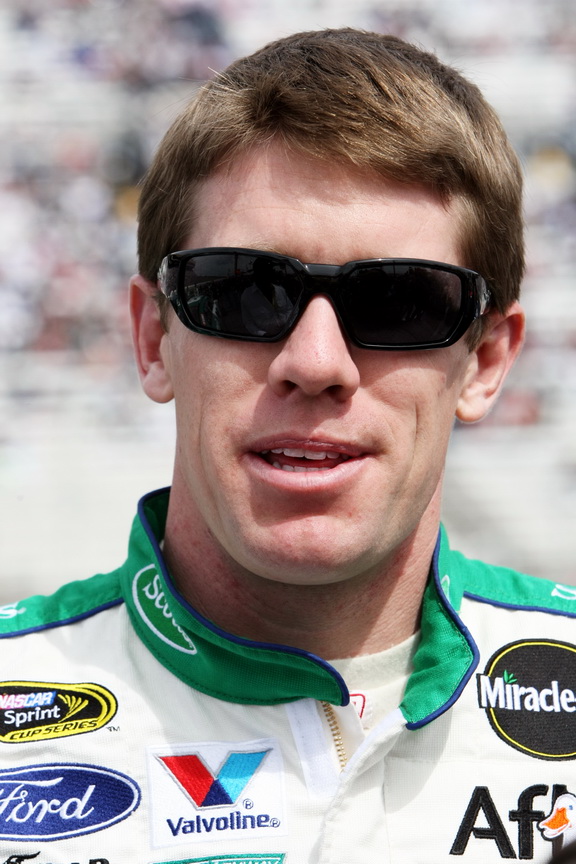NASCAR’s New Policy Backfires
 |
| Carl Edwards |
NASCAR’s new doctrine of letting the drivers police their own actions on the track took a big step backwards on Sunday, as Carl Edwards took the policy to the extreme in an apparent act of retribution against Brad Keselowski in the closing laps at Atlanta Motor Speedway.
Edwards, running nearly 150 laps down to the leaders, hooked the rear bumper of Keselowski’s car and sent him sailing roof-first into the frontstretch wall.
Keselowski was shaken up but otherwise unhurt in the crash. No one in the grandstands were injured.
The move appeared to be in retaliation for an earlier incident on lap 40, when Keselowski got into Edwards’ rear bumper, sending him into the wall and back to the garage for repairs.
With a patched-up racecar, Edwards re-joined the field and after several unsuccessful swipes at Keselowski, Edwards finally connected as they came down the frontstretch.
Television replays clearly showed Edwards’ white-gloved hands jerk the steering wheel to the right as we approached Keselowski’s left-rear bumper, looking to all the world as an intentional act of revenge.
NASCAR agreed, ordering Edwards to park his car for the day and report to the NASCAR trailer.
To Edwards’ credit, he did take full blame for the incident, all but admitting on national television after being parked that he intentionally spun Keselowski.
The result, however, was not what he intended.
“The scary part was his car went airborne, which was not at all what I expected," said Edwards said. “Brad knows the deal between him and I.I wish it wouldn’t have gone like it did, but I’m glad he’s okay."
The incident has left NASCAR eating their own words and facing a firestorm of criticism for what many saw as an example of a flawed attempt by NASCAR to satiate their “core" grassroots fans.
On the preseason media tour in January during their annual “state of the union" address, NASCAR Vice President of Competition Robin Pemberton announced the sanctioning body would back off from policing drivers actions, instead allowing them to settle it amongst themselves on the track.
“We will put it back in the hands of the hands of the drivers and we will say ‘boys, have at it and have a good time’, that's all I can say," said Pemberton.
While it’s clear that what NASCAR had in mind with this approach was to emphasize certainly rivalries and get the drivers back to trading paint, rubbing fenders and leaning on each others cars like Dale Earnhardt and Tim Richmond used to do back in the “good ol’ days, what NASCAR got instead was Keselowski’s car sailing into the fence, where it easily could have hurt someone sitting in the grandstand.
But, as if to reiterate NASCAR’s point, the two drivers do have a simmering rivalry, dating back to the April 2009 race at Talladega.
Coming through the tri-oval on the white-flag lap, Keselowski dived under Edwards, who then turned down into Keselowski and got spun back up the track and into the car of Ryan Newman, with the impact sending Edwards’ Ford Fusion sailing into the catch fence.
Edwards was unhurt, but several fans in the grandstands were injured – including one serious injury that sent a young girl to the hospital.
While the two incidents looked eerily similar, the circumstances surrounding them were much different.
“At least I didn't do it intentionally when it happened," Keselowski said Sunday of the Talladega incident. “It will be interesting to see how NASCAR reacts to it. They have the ball. If they're going to allow people to intentionally wreck each other at tracks this fast, we will hurt someone either in the cars or in the grandstands."
Now NASCAR faces the dilemma of how to mete out a punishment to a driver who took their “boys, have at it" philosophy and ran with it. How do they decide what’s a fair penalty after giving the competitors carte blanch to settle their differences on the racetrack using 3,500-pound stock cars their weapon of choice?
What NASCAR has done is painted themselves into a corner. No matter what punishment NASCAR slaps Edwards with, it will either be too harsh for the pugilists who support what he did or too lenient to satisfy their critics who say what he did was wrong and he should penalized.
Bottom line – what Edwards did was wrong, but it is NASCAR that is trying to cultivate this effort to get back to its heyday to satisfy its grassroots fans.
“Boys, have at it" is not the answer and it needs to be fixed, quickly, before someone gets killed.
